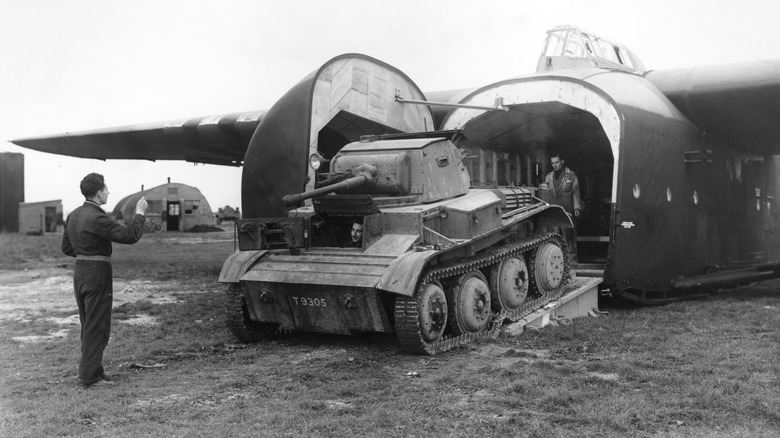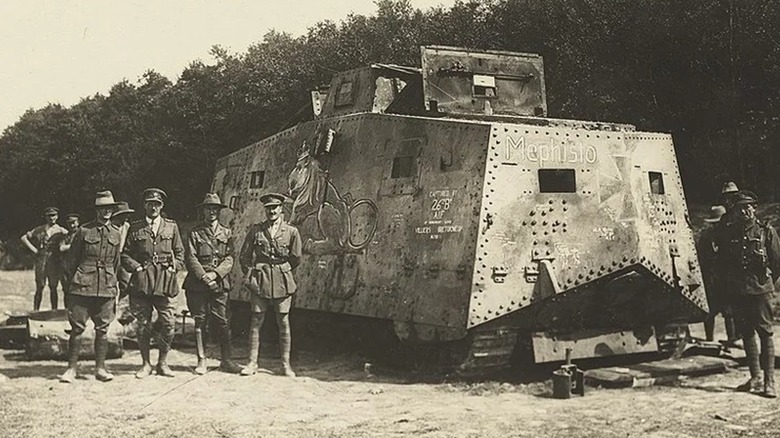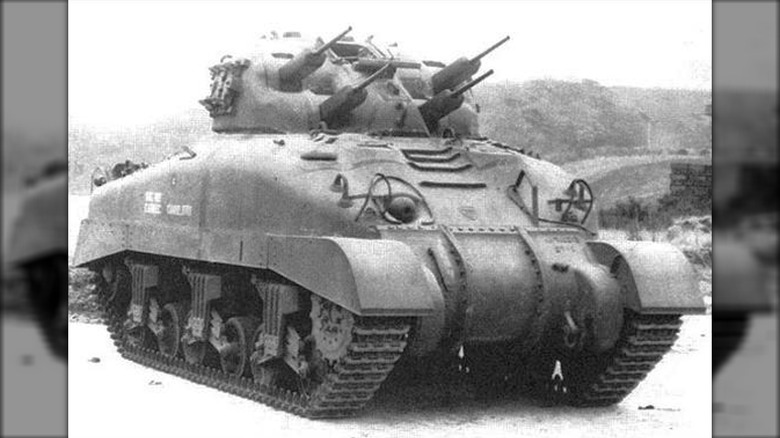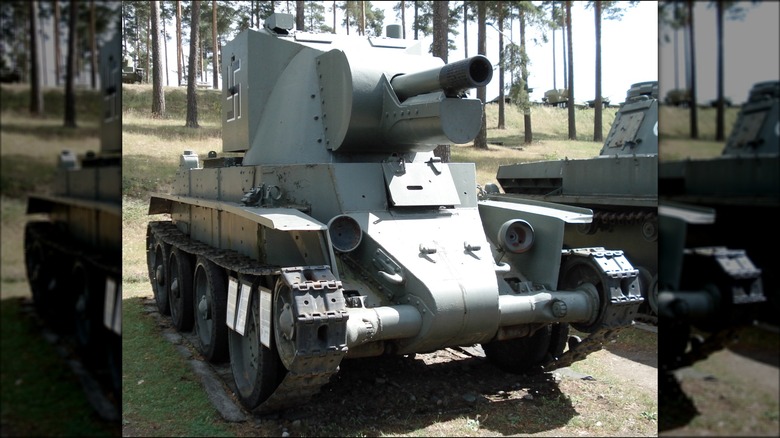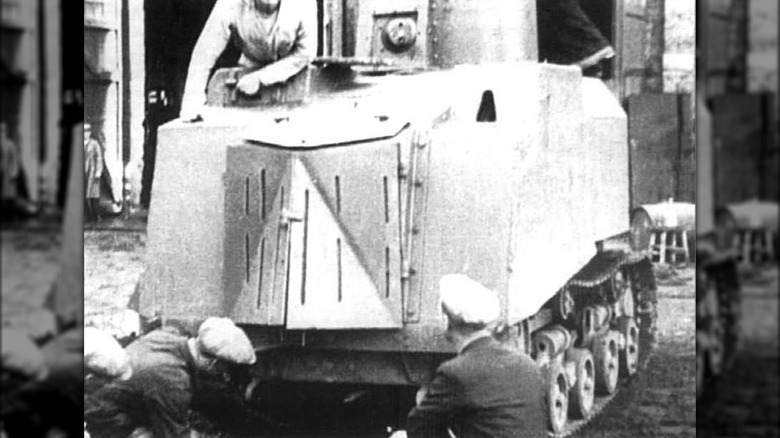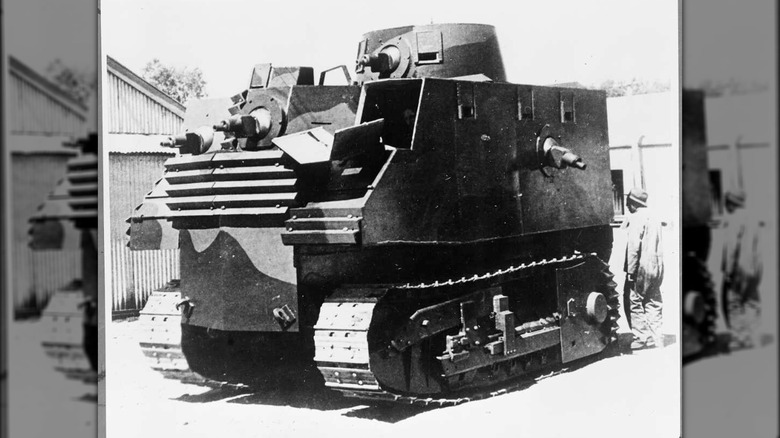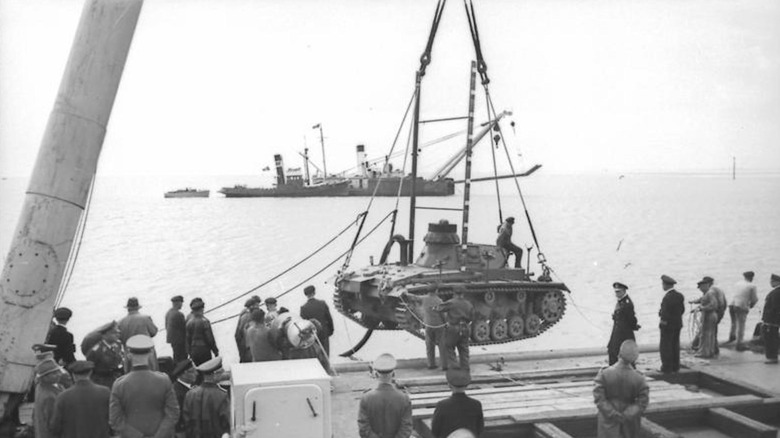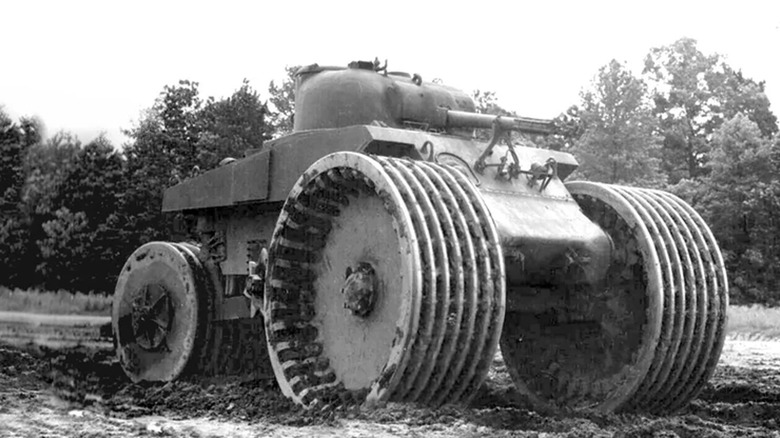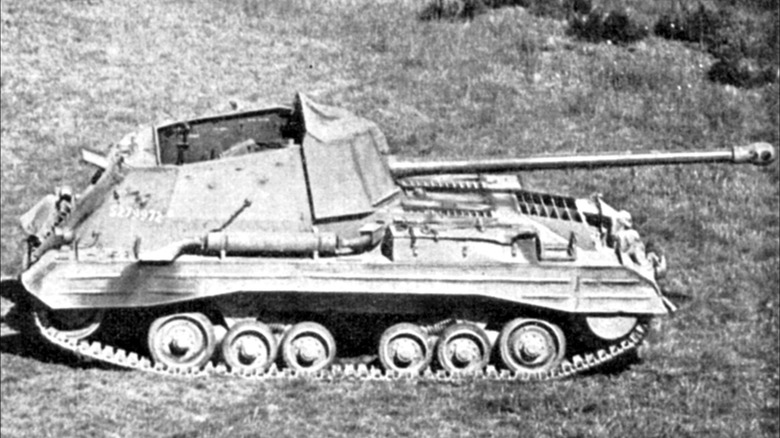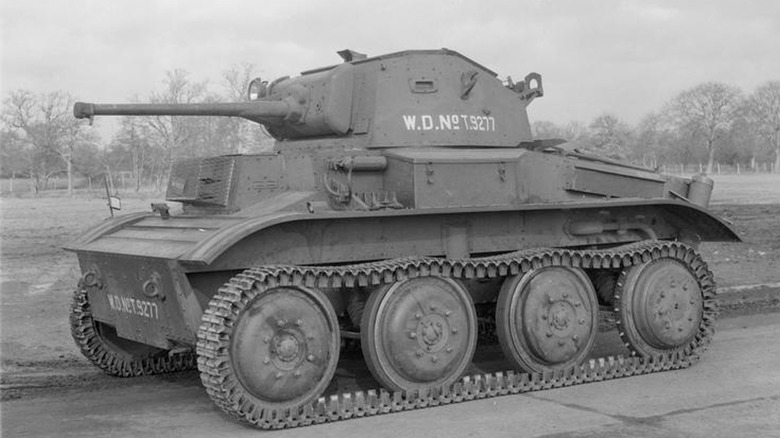Ten Of The Weirdest Tanks In History, Ranked
When you think of tanks, rumbling fortresses of armor and firepower usually come to mind. Over a century of use and technological upgrades have solidified this image along with the tank's role on the battlefield. To the untrained eye, the forms of even the best modern tanks might blend together. But step back in time to the genesis of tanks — and the decades to follow — and you might have trouble recognizing these vehicles.
The tank's first battlefield role influenced its initial design. Soldiers needed to be ferried across the No Man's Lands of World War I, so tanks were designed to be heavily armored. Moreover, they required treads so they wouldn't get stuck in all the mud, barbed wire, and trenches. Even the name "tank" originated from a designer ploy to fool potential spies. As wars and battlefield tactics evolved, engineers toyed around with tank designs. Sometimes they succeeded, other times they produced results akin to shoving a square peg through a round hole — while the hole was on fire and rigged to detonate. More importantly, some of these designs challenged the very definition of what it meant to be a "tank."
Here are 10 of the weirdest tanks to ever roll onto a battlefield.
Sturmpanzerwagen A7V
During World War I, German forces put much of their effort into defense. They dug in deep with their trenches — figuratively and literally — and bolstered these locations with machine guns and howitzers. The tank was partially invented to counter Germany's firepower, but since German forces didn't have to overcome similar odds, they didn't really need tanks. So when Germany finally built one, it was weird.
The Sturmpanzerwagen A7V was a heavy tank that hit battlefields in 1918 (the last year of World War I) and was Germany's only operational tank. The vehicle was overloaded with artillery and sported a unique shape, almost resembling an ambulatory loaf of bread. Each A7V was armed with one 5.7 cm cannon and six 7.92 mm machine guns. Despite being designed to counter British tanks, A7Vs were built without armored steel plating, which meant they weren't quite as bulletproof as the tanks they were competing against. Plus, A7Vs had comparatively low ground clearance, so they couldn't crawl over trenches and mud quite like British tanks.
The A7V's most noteworthy (and weirdest) feature was its crew size. Many tanks were manned by no more than eight soldiers, most of whom were devoted to piloting the vehicles, but the A7V fielded crews of anywhere from 18 to 24. Twelve of these combatants were devoted to handling and loading the machine guns. Not only were soldiers packed into these tanks like sardines, but they had to share their space with the engine and all the noise and fumes it produced. While the Sturmpanzerwagen A7V proved effective in many fights, its flaws outweighed its strengths, so German engineers started designing successor tanks. But since World War I ended the year the A7V premiered, those plans were never put into production.
[Featured image by Tasmanian Archive and Heritage Office Commons via Wikimedia Commons | Cropped and scaled]
Skink AA
The Luftwaffe was the key to many of Nazi Germany's early successes during World War II. This air force boasted superior pilots and technology, which put the rest of the world on edge. Many nations brainstormed how to fend off German bombers, and Canada's solution was to construct a fleet of motorized anti-aircraft guns.
The Tank AA, 22 mm Quad, Skink (or just Skink for short) was built for two purposes: peppering transport vehicles with bullets and shooting down attack planes. Engineers started with a Grizzly Mk.I, itself a modified M4A1 Sherman, which dominated the battlefield long after WWII. They replaced the main cannon with four 20 mm Polsten machine guns, and to make sure gunners could keep up with Luftwaffe fighters, they doubled up the Skink's motors to make sure the turrets could rotate faster. Because the Skink was outfitted with anti-aircraft guns, it was never paired up against Axis tanks. Even if Skinks had been sent to battle German tanks, they would have lost every such encounter due to a lack of armor-piercing rounds. However, the Skink proved effective at flushing out enemy foot soldiers. In several instances, Nazi forces surrendered after getting an earful of a single Skink Polsten gun burst, even though most soldiers were unharmed.
All of the previously mentioned changes resulted in a tank that wouldn't look out of place in a "Metal Slug" game. Originally, Canadian forces planned to manufacture 265 Skink tanks — 135 for the Canadian Army's defense, 130 for British forces overseas. However, after Allied forces all but wiped out the Luftwaffe's presence in Northwest Europe, the Skink was deemed superfluous, and production was canceled after only three were completed. Even the manufacture of Grizzly tanks was halted because the base Sherman model was so effective on the battlefield.
[Featured image by M.anderson via Wikimedia Commons | Cropped and scaled | CC BY-SA 4.0]
BT-42
The world of tanks is full of misconceptions. Not all tanks are slow, they are far from impervious, and many are not built from scratch. During wars and other armed conflicts, armies often capture tanks and Frankenstein them together with other weapons. The results look as mismatched as, well, the various body parts of Frankenstein's monster.
When World War II started, Finland's only tanks consisted of modified World War I-era Renault FTs. Despite this disadvantage, Finnish forces managed to fight off and capture numerous Russian tanks, including a fleet's worth of pre-war BT-7s. The country's leadership agreed they should modify the BT-7s to give their soldiers even more of an edge — a decision that resulted in what would be known as the BT-42.
To increase the vehicle's firepower, Finnish engineers replaced the BT-7's cannon with some surplus QF 4.5-inch Mk.II howitzers. While these artillery weapons were powerful and armored, once attached to the tank, they were taller than other tank turrets of the time, which made BT-42s stand out on battlefields in the worst way possible. Unfortunately, this high profile was the least of a BT-42 crew's concerns. The howitzers weighed down the aging BT-7 engines and suspensions, were ineffective against Russia's speedy tanks, and turned into crew-slicing shrapnel when hit by virtually any form of munitions. Ironically, Finland's forces might have been better off had they not invented one of the few tanks that was taller than it was wide.
[Featured image by Balcer~commonswiki via Wikimedia Commons | Cropped and scaled | CC BY-SA 3.0]
Odessa Tank
Tanks share a lot of DNA with tractors. The world's first tank, Britain's Little Willie, was designed by the agricultural firm and tractor manufacturer William Foster & Co. Plus, the grandfather of the tank, the Hornsby tracklayer, was a tractor that pulled a 60-pounder gun. When armies required tanks built quickly, they sometimes used tractors as a base.
Between August and October of 1941, Nazis partnered with Romanian forces to invade the Ukrainian city of Odessa — this was when Ukraine was part of the Soviet Union. The local Soviet army only had 70 tanks, all of which needed constant repair. So factory workers came up with a new strategy: Scare invaders into thinking they had more armored vehicles than they actually did.
Called the Odessa Tank and alternatively the NI tank (insert your own "Monty Python and the Holy Grail" joke here), these vehicles were built in a little over a week. Workers started with an STZ-5 tractor — military vehicles designed to haul guns and howitzers — and built a hull of naval steel around it. For weapons, workers used whatever they could find. Armaments included a DT machine gun, a 45 mm gun, a ShVAK autocannon, and even a flamethrower. Despite being built under strict time constraints and without any blueprints, Odessa tanks reportedly exhibited high degrees of standardization, armaments notwithstanding. Moreover, the vehicles succeeded as psychological weapons and as actual tanks. Then again, even the most improvised of tanks tend to scare away invaders who aren't expecting them.
[Featured image via Wikimedia Commons | Cropped and scaled]
Bob Semple Tank
During World War II, Japan tried stretching its influence as far as possible by invading nearby countries bordering the Pacific Ocean, including island nations. The citizens of New Zealand thought they'd be next, but while they had little in the way of armored vehicles, they were confident Great Britain would supply tanks to aid in their defense. When it became clear the tanks weren't coming, New Zealanders had to make due with what they had, which wasn't much.
While the New Zealand Defence Department had requested supply armor plates and tank blueprints from the United States, then-Minister of Works Robert Semple thought they couldn't sit around and wait. What if Japan invaded before the materials arrived? This rationale spurred him to work with the Public Works Department shops in Temuka to create the best tanks they could with the materials available. The result, colloquially known as the Bob Semple Tank, is widely regarded as one of the worst tanks in history.
The Bob Semple Tank looks like the kind of vehicle a "Warhammer 40K" fan would build if they tried creating an Ork trukk out of cardboard. Like the Odessa Tanks, Bob Semple Tanks used tractors, specifically D8 tractors, as their base, but the similarities end there. New Zealand workers fortified their creations with corrugated manganese plates and Bren light machine guns — nobody could get their hands on working cannons for the project. The closest anyone had to blueprints was a picture of an American tractor-to-tractor-tank conversion. The Bob Semple tank looked so shoddy and performed so poorly that it, and by extension Semple himself, became the laughing stock of New Zealand. Why did anyone go ahead with the plan? Because at the time nobody had any better ideas.
[Featured image via Wikimedia Commons | Cropped and scaled]
Tauchpanzer
Nazi Germany tried its best to invade Great Britain. The Luftwaffe bombed key targets, including London, but the British just would not crack. If the Luftwaffe had succeeded, though, Germany would have followed up by attacking with a submersible tank.
The Tauchpanzer was a conversion of the Panzerkampfwagen III and IV (better known as the Panzer III and IV) that rendered the tanks watertight. Even the sections that couldn't be made watertight, such as the hull machine gun and turret, were sealed with inflatable rubber sheeting. And to prevent their soldiers from suffocating, engineers ran long hoses from buoys to the tank's innards. If test records are to be believed, the Tauchpanzers would have survived their submerged skirmishes, and even if they didn't, each tank was outfitted with pumps that could drain water in an emergency.
Imagine, if you will, a World War II battle where the Nazis invaded Great Britain by sailing across the English Channel and dropping troops and vehicles on British shores to conquer the nation. Now imagine those forces being bolstered by tanks crawling out of the water like evil, goose-stepping metallic crabs. That hypothetical event, dubbed Operation Sealion, was the end-game of Nazi Germany's campaign against Great Britain, and the Tauchpanzers were built specifically for that attack. Thankfully, because the Luftwaffe failed, the Nazi high command postponed Operation Sealion indefinitely without actually canceling it. In light of this development, the Tauchpanzers and their crews were allegedly reassigned to participate in Operation Barbarossa — i.e., the invasion of Russia — and were outfitted with shorter hoses more suited to streams and rivers.
[Featured image by Balcer~commonswiki via Wikimedia Commons | Cropped and scaled | CC BY-SA 3.0 DE]
T10 Mine Exploder
After World War I demonstrated the effectiveness of the tank, armies thought up anti-tank countermeasures. During the war, landmines proved particularly effective, so Germany developed a variety of anti-tank models, many of which were used during World War II. In response, the Allies had to come up with anti-tank countermeasure countermeasures, many of which looked ridiculous.
The T10 Mine Exploder (aka the world's toughest tricycle) was part of a series of mine-clearing devices designed for M4 Sherman tanks. However, unlike most of the line, which consisted of strange add-ons, the T10 was a converted Sherman. Engineers essentially removed the treads and replaced them with giant metal rollers. The result looked like a cross between a tricycle and a steamroller, although some have likened it to a penny farthing bicycle.
Admittedly, the T10 Mine Exploder wasn't the first time engineers designed a tank with giant wheels. Russia's Lebedenko Tank, better known as the Tsar Tank, sported wheels taller than the tank itself, but unlike that failed design, the T10 Mine Exploder's wheels mostly functioned as intended. Its rollers were durable enough to withstand mine explosions, and they lifted the floors of the tank high enough to avoid the brunt of explosions. And what little shrapnel hit the undersides had trouble penetrating the extra armor engineers added, because you can't be too careful around landmines. Unfortunately, the T10 didn't last very long on the battlefield since the sheer weight of the rollers made these vehicles sink into the mud. And when mud didn't swallow tanks, it got stuck in their rollers, preventing them from detonating mines. Not even the star-shaped mud scrapers added later in the T10 Mine Exploder's life could help.
Progvev-T Gasdynamic
Russian engineers have created quite a few crazy tank concepts. For instance, the super-heavy Object 279 tank looked like a UFO on treads, and the previously mentioned Tsar Tank was a trackless prototype that didn't live up to expectations. But have you ever envisioned a tank that would fill a non-combative support role? Russians sure did.
As previously stated, landmines were a serious hazard during World War II, and each army came up with its own solution. American forces rolled them over with tank-powered steamrollers. The British constructed drums that whipped around heavy metal flails. And Russia strapped a jet engine to a tank. Dubbed the Progvev-T, this monstrous minesweeper combined the mighty Klimov VK-1 turbojet engine that powered the iconic MiG-15 fighter jet with the durability and weight of the Soviet T-55 tank. The engine replaced the tank's turret, which rendered the vehicle unable to fire on enemies — and made it look almost as ridiculous as the Maser Tanks you sometimes see in "Godzilla" films.
Whereas British and American tank crews could only detonate mines by hitting them with their various anti-mine attachments — while hoping the explosions didn't damage anything — the Progvev-T was designed to literally blow mines away. Just point the Kilmov VK-1 engine in any given direction and watch the mines blow away, prematurely detonate, or both. At least, that was the plan. Instead, the Progvev-T wasn't that good at its job. To make matters worse, the tank's unique silhouette made it easy to recognize — and an easy target due to its lack of weapons. Allegedly, the Progvev-T was occasionally used to put out oil well fires, but what happened to the vehicle? Nobody knows.
Archer
During World War I, the Germans learned a harsh lesson on the effectiveness of tanks, so when World War II rolled around, Nazi forces went whole hog with tanks of their own. German tanks dominated battlefields, so in response, the Allied forces focused on heavy artillery designed to decimate tanks. The only problem was getting them into position.
The Ordnance QF 17 Pounder was one of the most powerful anti-tank weapons available to the Allies, but since it wasn't very mobile, the British Army's top brass demanded the gun be motorized. To save money, engineers combined the QF 17 Pounder with one of Britain's cheaper (yet still reliable) tank chassis, the Valentine infantry tank. This marriage resulted in the Archer, a self-propelled 17-pounder anti-tank gun. If you look at the Archer tank from the side, you might not see anything weird about its design, but look from the front or back and you'll immediately notice that the cannon is facing the wrong way.
Unlike every other tank in history, the Archer's cannon faces backward. This was an intentional design choice to prevent the Ordance's prodigiously long barrel from bumping into anything. However, this unorthodox flaw was turned into an advantage. Since the cannon faced the rear, Archer crews could ambush potential targets and make a hasty retreat without turning around. And speaking of ambushes, the Archer's profile was kept low to the ground to make it harder to spot. Sadly, due to unfortunate timing, the Archers were ready for deployment around the time the Allies had begun a strong offensive, which made the tank's defensive design far less attractive.
[Featured image via Wikimedia Commons | Cropped and scaled]
Tetrarch
To turn a tank, you have to speed up the treads on one side while slowing down or even reversing the treads on the other. This design runs contrary to what you learn in driving school, so even if you know how to drive a car, you have to relearn everything to drive a tank. Unless you drive the Mk. VII Tetrarch
At first glance, the Light Tank Mk. VII Tetrarch looks like a normal tank. The vehicle was designed to improve upon the Light Tank Mk. VI with superior firepower. However, the Tetrarch did more than that thanks to its treads. Unlike other tanks, the Tetrarch's treads ran on four large road wheels that also served as track supports and suspensions, as well as additional armor. The front wheels also held a secret: They could swivel like a car wheel, and the treads would follow. This design let the Tetrarch turn much like an automobile, although drivers could alter the speed of one tread to pull off tighter, tankier turns.
Despite this novel turning system (for a tank), Tetrarchs actually had horrible track records. At just under 8 tons, Tetrarchs carried less armor than any other tank on the battlefield. Whenever a Tetrarch fought a German tank, the German tank won. However, due to this disadvantage, carrier planes could transport Tetrarchs and drop them in areas Axis forces didn't expect. Cue D-Day. During the invasion, British planes deposited a platoon of Tetrarchs behind enemy lines, which scared the Nazis enough to send the 21st Panzer Division after them instead of using their tanks to reinforce Normandy Beach. And in typical Tetrarch fashion, many of the air-dropped tanks got temporarily tangled in their own parachutes. The Tetrarchs were such a huge failure, they helped win the war.
[Featured image via Wikimedia Commons | Cropped and scaled]
